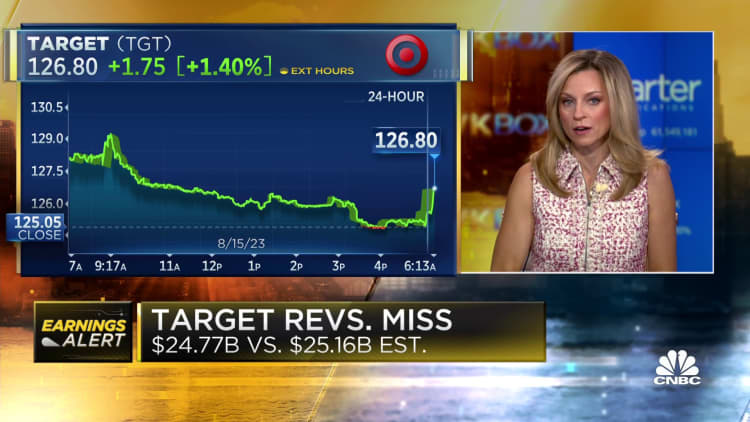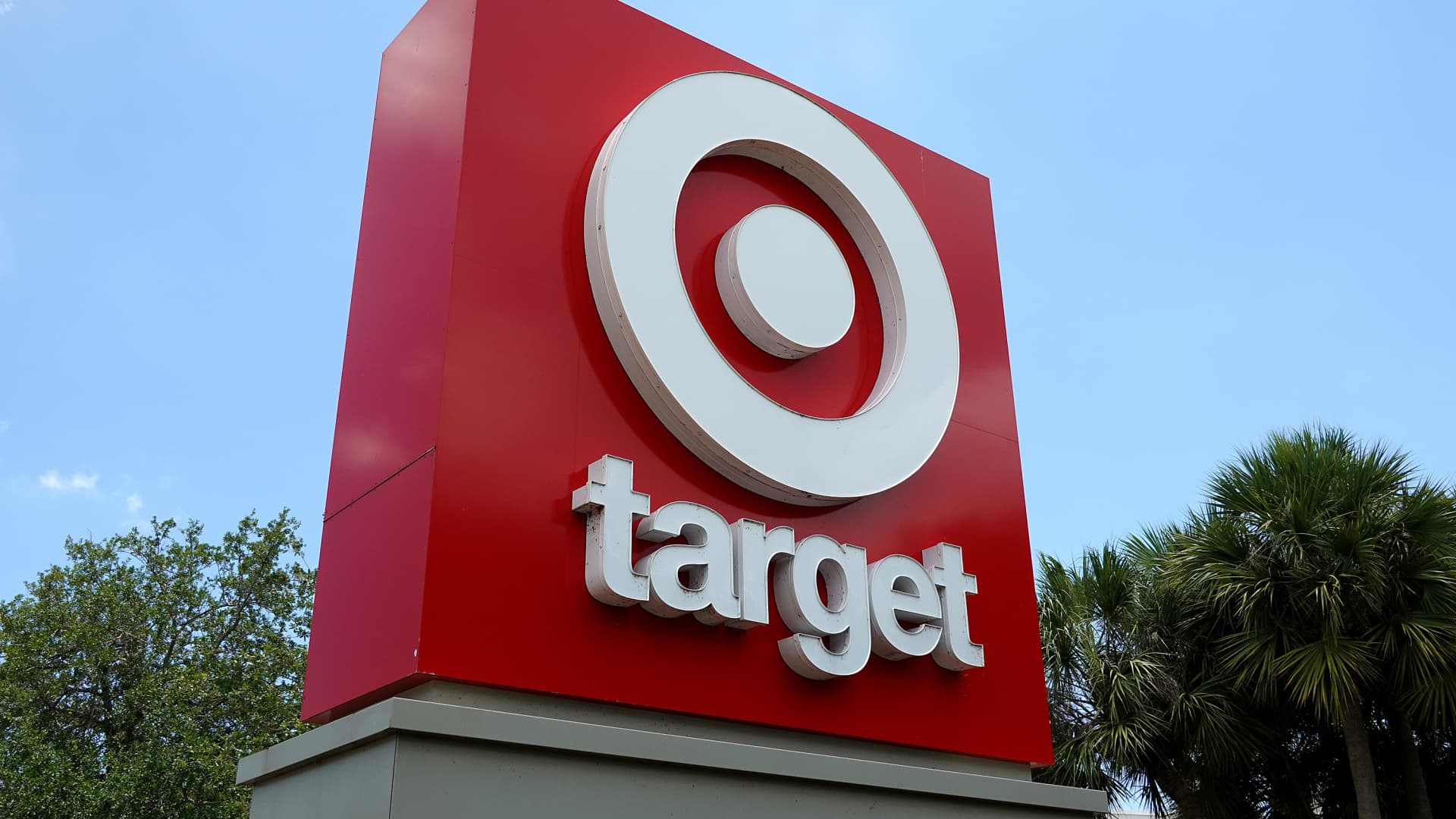
Target missed analysts’ expectations for quarterly sales and reduced its full-year forecast on Wednesday. The retailer continues to struggle in convincing customers to buy beyond necessary items.
Target has revised both its full-year sales and profit expectations. This revised outlook comes at a time when some leading economists have abandoned predictions of a recession and government data shows signs of inflation cooling off.
The company now anticipates comparable sales to decrease by approximately mid single digits for the full fiscal year, with earnings per share ranging between $7 and $8. Previously, Target expected comparable sales to range from a low single-digit decline to a low single-digit increase, and earnings per share to fall between $7.75 and $8.75.
Despite the soft forecast, Target’s struggling shares rose 3% on Wednesday as the retailer reported better-than-expected fiscal second-quarter earnings and improved inventory levels. Investor expectations for the company have been low, resulting in a significant share price decline this year leading up to Wednesday.
CEO Brian Cornell mentioned that Target saw an improvement in sales and store traffic in July. However, the company remains cautious about trends in the latter half of the year, including rising interest rates, the return of student loan payments, and persistently high prices of everyday essentials.
Cornell stated on a call with reporters, “As we look at the consumer landscape today, we recognize the consumer is still challenged by the levels of inflation that they’re seeing in food and beverage and household essentials. So that’s absorbing a much bigger portion of their budget.”
Here are the highlights of Target’s report for the three-month period ending in July, compared to Refinitiv consensus estimates:
- Earnings per share: $1.80 vs. $1.39 expected
- Revenue: $24.77 billion vs. $25.16 billion expected
Sales decline after Covid boost
Target’s struggles to attract customers amidst inflationary pressures have negatively impacted its stock. As of Tuesday’s close, Target shares had fallen 16% this year, in contrast to a 15% increase in the S&P 500 index. The stock price hit a 52-week low of $124.96 on Tuesday, nearly halving its pandemic highs.
Target’s challenges persisted in the recent quarter, with total revenue declining about 5% from $26.04 billion compared to the same period last year.
Comparable sales, a key metric tracking online and in-store sales for at least 13 months, dropped by 5.4%. This decline was larger than the estimated 3.7% drop by analysts according to consensus estimates from StreetAccount.
For stores, comparable sales declined by 4.3%, while digital comparable sales decreased by 10.5%.
Sales weakened from the second half of May through June before recovering in July, according to Cornell. He attributed the recovery to the Fourth of July holiday and Target Circle Week, a competing sale to Amazon Prime Day.
Target’s Chief Financial Officer, Michael Fiddelke, mentioned on the call with reporters that it is difficult to determine the main contributing factors to the slower sales. However, customers continued to reduce their purchases of clothing, home decor, and other nonessential items while paying more for food, energy, and rent. Sales also declined compared to the year-ago period when targeted discounts helped clear excess inventory.
Additionally, Target faced backlash in late May over its Pride month collection, which included some items that were later pulled due to threats against employees. The decision to remove certain items generated further criticism. Cornell stated that the “negative reaction” to the Pride collection had a material impact on sales but defended the company’s response. He mentioned that the situation normalized after Target removed some items in June to prioritize employee and customer safety. Cornell confirmed that Target will continue to have collections for Pride month and other heritage months.
Rebuilding profits
Despite the decline in sales, Target’s profits rebounded. In the fiscal second quarter, net income rose to $835 million, or $1.80 per share, compared to $183 million, or 39 cents per share, in the same period the previous year. This exceeded analysts’ expectations.
In the previous year’s quarter, the retailer’s quarterly profit had plummeted by almost 90% as it dealt with an excess of unsold items. Target took decisive actions to cancel orders, reduce prices, and clear inventory, as customers purchased fewer popular pandemic-related products and became more cautious due to inflation.
Fiddelke emphasized Target’s progress in reversing these trends. He stated, “We had talked about this year being a really important year in terms of building back the profitability of the business, and for the team to take a big step forward in the second quarter in spite of softer-than-expected sales is really great progress on that journey.”
Aside from company-specific actions, Target attributed its improved profits to lower markdowns, reduced freight costs, streamlined supply chain and online fulfillment expenses, and higher retail prices. However, higher shrinkage, partly due to organized retail crime, negatively impacted profits.
Inventory at the end of the quarter decreased by 17% compared to the same period last year. The decrease in inventory also reflects a 25% year-over-year drop in discretionary categories.
Over the past year, Target has adjusted its product mix to focus on high-demand categories such as groceries and household essentials. The company stated that growth in these areas helped offset declines in discretionary categories during the fiscal second quarter.
Target’s Chief Growth Officer, Christina Hennington, mentioned that certain items are still attracting customer interest, including brightly colored Stanley tumblers, Barbie-themed merchandise, and a Taylor Swift vinyl exclusive to Target. Beauty products have also contributed to revenue growth, with sales at Ulta Beauty at Target more than doubling compared to the previous year, and sales of other beauty items increasing by double digits. Snacks, candy, and beverages have fueled growth in Target’s food and beverage category.
Hennington stated that as Target strives to boost sales for the remainder of the year, the company is focused on offering affordable prices, maintaining stock levels of frequently purchased items, and capitalizing on major seasons like back-to-school.
She mentioned on the call with reporters, “We’re gonna play the long game. We don’t carry our assortment for a moment in time, but we’re going to lean into the kinds of things that have made Target Target.”
Denial of responsibility! VigourTimes is an automatic aggregator of Global media. In each content, the hyperlink to the primary source is specified. All trademarks belong to their rightful owners, and all materials to their authors. For any complaint, please reach us at – [email protected]. We will take necessary action within 24 hours.


